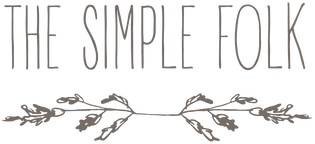Sometimes healthy choices are straightforward—like nourishing your family with whole foods, encouraging adventurous outdoor play, recycling, and opting for wooden or rubber toys.
But other times it can be more challenging, especially when it comes to choosing clothing for your children. I know it was for me as I decidedly sought out simple, eco-friendly clothing for my kids that was made in the healthiest, most ethical way possible.
In the end, that’s what led to the birth of The Simple Folk.
With so many labels and certifications out there, it was initially difficult to discern which dyes, washes, and fabrics contained man-made toxins. Because I previously had my own personal health battle with a parasite, I had firsthand knowledge that these artificial elements present in our food, environment, and clothing (which we wear and dress our children in every.single.day.) can really do a number on our microbiome and our health.
What’s more, so much of the clothing that harbors these ingredients is made using unethical and unsustainable business practices, creating unnecessary physical and financial stress on our global ecosystem.
Here’s what I’ve discovered: When prioritizing the health of my family, my home, and our planet, the best place to start is by choosing garments that have been made from natural fibers like cotton, linen, and wool with non-toxic dyes.
But it’s important to understand that not all natural fabrics are created equally. I’ve outlined the differences below, so you can make the most informed choice for your family.
How Are Organic and OEKO-TEX® Fabrics Different?
The simplest way to understand the distinction between these two important standards is that organic and OEKO-TEX® certifications involve different stages of a fabric’s journey, from tiny seeds to a finished, consumer-friendly product:
• Organic fabrics must adhere to strict guidelines during the growth and farming stage of the individual plants that are later woven to become fabrics.
• STANDARD 100 by OEKO-TEX® regulates what happens during the time that the raw fabric is processed into consumer-ready products like clothing, bedding, and towels, and it ensures that the final product is free from harmful levels of 100 known dangerous substances.
Organic Fabrics Explained
Organic farming provides a great start for safe, natural, ecologically responsible fabrics. For a material to be considered organic, the plants involved must be grown using environmentally friendly, sustainable methods that encourage diverse agriculture—and without the use of toxic and persistent pesticides or synthetic fertilizers. Genetically engineered seeds are also prohibited in organic farming, so you can be assured that organic fabrics are non-GMO.
While this is all good news, the surprising truth is that the fact that a fabric is organic doesn’t necessarily mean it’s safe for your child to come in contact with. A garment made from organic fabric might also contain harmful chemical dyes, threads, or ornaments that you wouldn’t want near your little one. And that’s why I love the OEKO-TEX® certification (and why all of our pieces are STANDARD 100 certified).
Why We Stand by the STANDARD 100 by OEKO-TEX®
Organic farming creates safe, natural, environmentally responsible raw fabrics, but an organically farmed fabric alone doesn’t guarantee that the clothing your child wears is actually non-toxic. Just as baking some organic apples into an artificially flavored, chemically preserved pie crust loaded with GMO additives would create a very unwholesome pie, organic fabrics still run the risk of becoming toxically contaminated during the manufacturing process.
That’s where OEKO-TEX® comes in, picking up the baton right where organic leaves it. STANDARD 100 by OEKO-TEX® ensures that the completed product—which might include dyes, linings, thread, buttons, and other accessories—is free of harmful chemicals and is safe for human use. This certification involves:
• A global standard
• Voluntary participation
• Annual review of criteria
• Independent, third party testing to verify that each product is free of damaging levels of over 100 substances known to be dangerous to human health. This testing takes into account all the ways these substances might enter a body, from direct skin contact to inhalation of fumes.
A Simple, Safe Approach for Your Children
Luckily, the answer to the organics vs. OEKO-TEX® question doesn’t have to be an “either/or” kind of thing.
Many of the organic pieces in our collection are also GOTS certified*, which is the highest worldwide standard for the processing of organic fibers. GOTS certification ensures that each certified textile product is truly organic, safe for you and the planet, and fair to all the workers involved in producing it.
The bottom line for me when making choices for my family is to always go with OEKO-TEX® for the peace of mind that the clothing touching my kids’ skin is completely safe and non-toxic, and then to back it up with GOTS certification for all our new organic styles.
What I love most about our collection at The Simple Folk is that every aspect of our clothing and sleepwear—including dyes, threads, and embellishments—meets that vital STANDARD 100 by OEKO-TEX® (and we also use GOTS certified organic fabrics as often as possible).
With so many toxins, harsh chemicals, and even synthetic fabric compositions hiding out in baby and children’s apparel, we’ve intentionally chosen a different path and are devoted to helping keep your child’s wardrobe free from anything you wouldn’t want touching their delicate skin.
When you can rest assured that only the safest fabrics come into contact with your child’s growing body, you have one less thing to worry about—and more space to be present for the moments that matter, like joining your child in rolling down hills, reading stories, and putting in some serious cuddle time together.
*All of our qualifying GOTS-certified products are labelled as such on the individual product pages.
